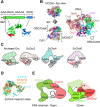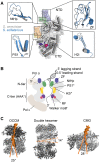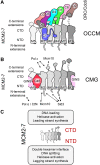From structure to mechanism-understanding initiation of DNA replication
- PMID: 28717046
- PMCID: PMC5538431
- DOI: 10.1101/gad.298232.117
From structure to mechanism-understanding initiation of DNA replication
Abstract
DNA replication results in the doubling of the genome prior to cell division. This process requires the assembly of 50 or more protein factors into a replication fork. Here, we review recent structural and biochemical insights that start to explain how specific proteins recognize DNA replication origins, load the replicative helicase on DNA, unwind DNA, synthesize new DNA strands, and reassemble chromatin. We focus on the minichromosome maintenance (MCM2-7) proteins, which form the core of the eukaryotic replication fork, as this complex undergoes major structural rearrangements in order to engage with DNA, regulate its DNA-unwinding activity, and maintain genome stability.
Keywords: CMG; DNA replication; MCM2–7; cryo-EM; pre-RC; replisome.
© 2017 Riera et al.; Published by Cold Spring Harbor Laboratory Press.
Figures






References
-
- Abrahams JP, Leslie AG, Lutter R, Walker JE. 1994. Structure at 2.8 A resolution of F1-ATPase from bovine heart mitochondria. Nature 370: 621–628. - PubMed
-
- Adelman JL, Jeong YJ, Liao JC, Patel G, Kim DE, Oster G, Patel SS. 2006. Mechanochemistry of transcription termination factor Rho. Mol Cell 22: 611–621. - PubMed
Publication types
MeSH terms
Substances
Grants and funding
- MC_U120085811/MRC_/Medical Research Council/United Kingdom
- BB/M003760/1/BB_/Biotechnology and Biological Sciences Research Council/United Kingdom
- BB/N000323/1/BB_/Biotechnology and Biological Sciences Research Council/United Kingdom
- 107903/Z/15/Z/WT_/Wellcome Trust/United Kingdom
- WT_/Wellcome Trust/United Kingdom
LinkOut - more resources
Full Text Sources
Other Literature Sources
Miscellaneous
